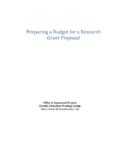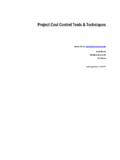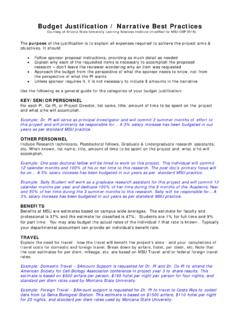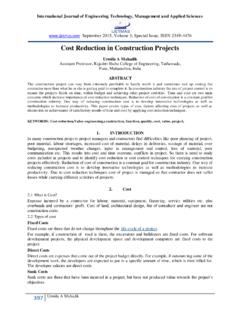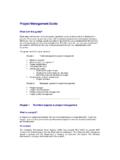Transcription of E Project cost and budget - Food and Agriculture …
1 E Project cost and budget 8. INCREMENTAL COSTS AND Project FINANCING .. 11 Summary Table of Incremental Costs .. 11 cost Effectiveness .. 12 Annex 1 INCREMENTAL COSTS ANALYSIS DESCRIPTION .. 14. Annex 8 Project budget .. 23 10. 8. INCREMENTAL COSTS AND Project FINANCING. The incremental costs and benefits of the full Project are presented below and in Annex 1 Table 1. The total incremental costs of the GEF Alternative amounts to an estimated US$ million of which US$. 7,000,000 (23% of the total cost ) represents the amount requested from GEF to fund the full Project . Co-funding of the 75% balance (US$ million) will be provided from the four participating countries, direct collaboration with regional programmes, local beneficiaries (communities, farmers and herders), FAO, and additional donor support. Summary Table of Incremental Costs Capital Costs Baseline-B Alternative A Increment A-B. (situation with GEF and Co-funding Project ). Outcome 1: Baseline: US$4,328,981 Alternative: Increment: US$4,083,393.
2 Transboundary Governments: US$ 1,563,000 US$8,412,374. GEF: US$1,766,873. coordination, Donor programmes; regional information sharing Co-funding (Governments, (NELSAP/ LVEMP; FAO- and monitoring and projects, beneficiaries) =. Africover etc.) US$ 1,944,760. evaluation US$ 2,316,520. mechanisms and national (RSSP;ASDP;. PMA) US$ 821,221. Outcome 2: Enabling Baseline: US$6,216,255 Alternative: Increment: US$1,696,662. policy, planning and US$7,912,917. Government and national donor GEF: US$423,342. legislative conditions programmes in place. Cofunding: US$1,273,320. US$ 5,066,255. Regional donor programmes US$ 1,150,000. Outcome 3: Capacity Baseline: US$15,446,004 Alternative: Increment: US$ 4,866,523. and knowledge for US$20,312,527. Government and Donor: GEF: US$ 1,230,003. the promotion of and US$14,485,684. technical support for Cofunding: US$ 3,636,520. SLaM in the basin Regional donor : US$ 960,320. Outcome 4: Baseline: US$18,219,885 Alternative: Increment: US$18,043,532. Improved land and US$36,263,417.
3 Government and Donor US$ GEF: US$2,360,682. agro-ecosystem 16,705,885. management Cofunding: US$ 15,682,850. practices Regional donor: US$ 1,514,000. implemented and benefiting land users in all agroecosystems in the basin. Outcome 5: Project Baseline incorporated in Alternative: Increment: US$ 2,182,800. management components above as not US$2,182,800 GEF: US$582,800. possible to separate Cofunding 1,600,000. Total Capital Costs Baseline US$44,211,125 Alternative Total: US$30,872,910. US$75,084,035. GEF: US$6,363,700. Cofunding: US$24,509,210. 11. cost Effectiveness During Project preparation, a number of options were examined to identify the most cost -effective approach to address land degradation issues in the very large and diverse river basin. This consisted of assessing (i) options for bringing about a change from unsustainable to sustainable agricultural management practices techniques and approaches and (ii) required institutional arrangements for agreeing on, planning and implementing options with stakeholders.
4 In regard to techniques and approaches, an option that was considered was a process that would spread interventions widely across the basin to reach as many communities as possible. In regard to institutional arrangements, an option was a focus on strengthening the institutional and regulatory framework for preventing degrading practices (establishing and enforcing laws and accelerating implementation of the national action plans (NAP) for combating desertification and increasing productivity through input supply. This would entail achieving a high degree of regional co-operation among the countries sharing the basin and efficient delivery by their multiple government bodies concerned with the various natural resources and agricultural services. In light of the size of the basin and very limited capacity of institutions in the basin (notably the district agricultural and planning office) and large distances for research bodies to reach the communities and taking into account lessons learned from other GEF- and FAO-supported projects, it was decided as the GEF alternative to use a more focused and two phase approach for cost effectiveness.)
5 First, to improve crop and livestock management practices with a limited number of selected communities, micro-catchments and transboundary land units to address specific issues identified and subsequently (PY3) to scale up successful practices more widely across the basin through FFS networking and district development plans building on demonstrations effect from proven SLM practices. Certain practices and approaches were identified during Project preparation ( conservation Agriculture , water harvesting, improved pasture management, rotational grazing, stall feeding, etc.). from the basin and wider region but require demonstration for local training, adaptation and validation through the collection of cost -benefit and impact data (environmental and livelihood). Thus when identifying the most suitable SLM practices to test and if proved successful to scale up, the national technical teams will draw on R&D results of successful land resources/agricultural management activities/projects and local knowledge systems and farmer innovations throughout the region.
6 Attention will be placed on selecting the target sites for their best demonstration effects and access to research /technical support to optimise success and help in assessing the environmental and socioeconomic impacts and benefits. This should facilitate subsequent scaling up and expansion across the basin using trained FFS facilitators and technical staff, according to the interest expressed by other communities and opportunities for collaboration and funding. Participatory adaptive management through FFS approaches should ensure that improved SLaM techniques are those prioritised and validated by the communities through FFS study plots. Participatory monitoring tools (such as LADA). and local indicators will be used to assess the impacts of pilot interventions on farms and in target micro-catchments and transboundary land units level to ensure they are technically and socially appropriate, cost effective and generate global environmental benefits in terms of reversing biodiversity, sustainable use of biodiversity, carbon sequestration and water supply.
7 Capacity building is an important part of the Project at farmer, district and basin levels and cost -effectiveness will be optimised through use of extension approaches that allow cost effective delivery and scaling up, building capacity of local institutions and NGOs, and development of user-friendly information and decision support systems. In regard to institutional support, instead of focusing on protection of resources and input support by the multiple sectors (seed, veterinary products, soil erosion control, irrigation, etc) for certain commodities, a focus will be placed on involving and building capacity of multi-sectoral teams in the districts for integrated ecosystem approaches that restore the health, productivity and resilience of farming systems. Demonstration of the multiple benefits generated is expected to increase district planning and budgetary support for the Agriculture sector notably for training and supporting FFS. approaches, community action planning and developing market opportunities for the products of biodiverse agro-ecosystems and incentives for sustaining valuable ecosystem services and adapting to climate change 12.
8 The selected strategy is the more cost effective option as it will avoid diluting financial and human resources among many target sites and many institutions which would risk achieving little impact after the Project years. Rather than agricultural specialisation which tends to increase vulnerability to climatic vagaries and markets, the agro-ecosystem approach is expected to also increase food security and livelihoods of the population through better resource use efficiency (nutrient cycling, rainwater retention), multiple and quality products (diverse foods, fuel, building materials, etc), and reduced risk of pest and diseases (biocontrol). Collaboration with interventions that address food security (social nets, nutrition, etc), agricultural services (supply of fertilisers, improved seed) and marketing should enhance the uptake and viability of the resulting productive and sustainable agroecosystems. The process of developing the full Project with all actors on the ground (PDF-B) has been instrumental in generating understanding of the added value of GEF funding and, as a result, substantial co-funding by districts, governments and partners and interest to cooperate in Project implementation.
9 The Baseline for the Project is also considerable, through financing of sectoral activities for water resources, crop and livestock development, forest management and coordinated water resources management in Nile and lake Victoria basins. Such efforts are evaluated at approximately US$ million throughout the Kagera river basin during the life of the Project . The investments are however, unevenly distributed across the basin and the countries and tend to focus either on development or conservation rather than an integration of concepts leading to sustainable land use and integrated ecosystem approaches. The high baseline will ensure that the GEF financing will be cost effective as the Project is expected to strengthen processes in the Kagera basin for intersectoral coordination and land use planning and mainstreaming land, water and agroecosystems management into district and national programmes and planning processes. 13. ANNEX 1 INCREMENTAL COSTS ANALYSIS DESCRIPTION. The Kagera River basin represents a globally important ecosystem and extremely important areas at the divide between Eastern and Central Africa in providing multiple environmental and economic services especially in terms of agro-biodiversity and the basis for sustainable livelihoods and food security of some million people and some million by 2015.
10 However, in the four countries that share the river basin (Burundi, Rwanda, Uganda and Tanzania), land degradation and the resulting loss of ecosystem structure and function has been a growing issue and exacerbated by refugee movements and reduced capacity due to the prevalence of HIV/AIDS. The sustainability of resource management in the Kagera basin through its effects on the hydrology and functioning of its aquatic and terrestrial systems, directly influences the Lake Victoria basin (shared among Uganda, Tanzania and Kenya), being the largest tributary and providing 24% of the inflow, and also directly influences the larger Nile Basin of which it is also a part. The rapid population growth and increased climatic variability has increased the vulnerability of the population in the basin and is resulting in land use change, land degradation, deforestation, fragmentation of land into smaller and smaller parcels and increasing pressures on limited and often fragile resources to meet household needs (food, firewood, etc.)












